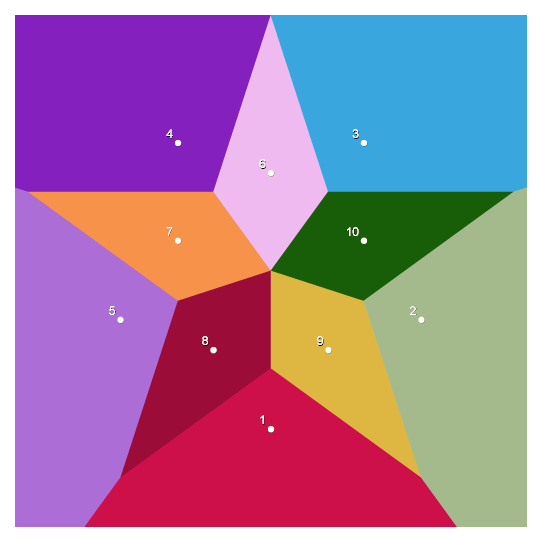Most superfluous output
Most Superfluous Output
Francois Boutines
Toulouse, France
francois.boutines@gmail.com
Contents |
Judges' Comments
To build
cc -o boutines boutines.c
To run
Go to http://www.adobe.com/svg/viewer/install/ and install an SVG viewer for your browser, then
perl -e 'map{print rand," ",rand,"\n";}(1..20);' | ./boutines > test.svg
and browse to test.svg. Can you explain the author's remark "[generated files] are not as scalable as their name suggests"?
Author's Comments
Walkthrough
My program works as follows :
- Input
- a list of 2D points in the unit square
- Output
- a Voronoi diagram of the set as an SVG stream
This will possibly save a compressed SVG file and may be useful :
./boutines | gzip > result.svgz
Input consists of a list of floating points values separated by whitespaces (ranging preferably in [0,1]). Alternating an horizontal coordinate, a whitespace then the other coordinate (pointing downwards in the resulting graph) and a newline will just go fine :
0 0
0 1
1 0
1 1
.5 .5
Strictly speaking, you have to provide a set of points. If there are duplicates in the list, there is no guarantee on the one to be shown (in addition their labels will overlap) in the resulting colored Voronoi diagram.
Caution
This program might have been a lot shorter, but nearly impractical even for medium sized datasets. On the other hand it could have been a lot faster, but hard to qualify under the IOCCC size limit. So guess what... I did a compromise favoring innermost obfuscation, sacrificing sometimes speed and other tedious factors.
Therefore this entry is limited to <math>floor\bigg(\frac{10^6}{4\times(sizeof(double)+1)}-1\bigg)</math> points and won't even be suitable for more than a few thousand : although generated files do pass W3C SVG Validator, and are highly compressible, they are not as scalable as their name suggests... For serious applications about Voronoi diagrams, see Qhull, CGAL and the like : but you may still encounter large output volumes (and have to handle some sort of clipping in order to represent properly infinite regions of the diagram in SVG).
Beware, compilation may report warnings about precision loss, linting may be a disaster, but the code should remain portable, and the output accurate enough for most devices (including many inkjet printers). If you ever miss precision on a particular dataset or peripheral, you may want to dive in and let U be the next power of __LINE__.
Note : bad inputs will be sanctioned by the production of the 42nd(?) Mersenne prime (ie. <math>2^{25964951}-1</math>), memory will be kept.
Why I think this code is Obfuscated ?
I'm quite divided on the subject because I wrote :
- clear SVG key words but complicated output statements
- no nested loops but loads of function calls
- easy recursion but no clear data struture
- easy maths but no use of math.h
- a single if
Be sure to check the antepenultimate line of code.
Missing Features
- Color control
- Cell colors are chosen randomly (with a questionable rejection scheme). It might have been useful to input them along with sites coordinates, turning the application into a puzzling graphics engine.
- Site labelling
- The points are implicitly numbered in the order they were entered (starting at one). This can be overridden however, via a simple XSL transformation.
- Site radius
- The site radius is hardwired in the code, I still wonder why I did not design it as a function of the underlying cell’s area (which can be averaged for free) or at least a command line parameter. Same with the char set, the viewport and potentially every SVG property.
See Also
An Excerpt from The Algorithm Design Manual
